by Winding Pathways | Sep 23, 2021 | (Sub)Urban Homesteading, Garden/Yard, Nature, Trees
Coppicing
What? Coppicing? That word almost sounds dirty. Well, it’s not. It is a good way to help derecho doomed trees live on!
We recently hosted friends to mark the first anniversary of the August 10, 2020, furious derecho that leveled around 70% of trees in the Cedar Rapids area.
Many people used words like devastation and destruction to describe what happened to trees in both forests and neighborhoods. The damage was truly shocking.
-
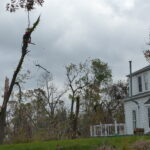
-
Trimming damaged trees.
-
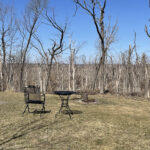
-
All winter we looked on broken trees.
-
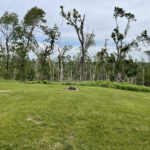
-
Springing Back from Derecho.
The Giving Trees
We wanted to show visitors a miracle of nature stimulated by the storm. Just east of our house stood a couple of basswood trees. Few of nature’s scents are as delightful as what comes from the blooms of this tree. Bees will fly three miles away to gather the nectar. We just enjoy the scent.
Basswoods have a problem. Their wood is soft and weak. When the derecho hit, they quickly snapped off, leaving a tangle of branches in our yard. Nearly a year later they demonstrated the power of near-perpetual youth.
-
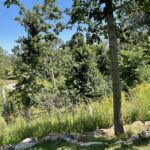
-
In the middle our basswood looks like a fuzzy brush.
-
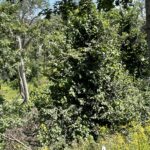
-
This basswood wants to live!
Basswoods, along with many other deciduous trees, readily coppice. If a tree is cut or blown down it sends shoots up from the stump. Our basswoods quickly sprouted this spring, and we’re seeing others sprouting from stumps in suburban yards. Many species of deciduous trees also send up shoots. Ashes, oaks, and honey locusts are common sprouters. Evergreens don’t. If a pine or spruce is cut off, the stump dies.
Woodland Management
In Europe coppicing is a method of woodland management. A tree is cut down and allowed to resprout. Because the regrowth is coming from a well-established root system, sprouts grow like crazy. The sprouts are managed carefully. The most hearty sprout is kept and the others cut off. Within five to twenty years, or so, the hearty sprout is big enough to cut for firewood, fence posts, or walking sticks. Then the stump resprouts again. Some trees have been coppiced for hundreds of years.
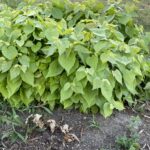
Basswood trees are champion sprouters. Our stumps now look like balls of green leaves from all the sprouts radiating from the stumps. This fall we’ll clip off all but the most vigorous one. It will quickly form a new tree. That’s better, easier and cheaper than grubbing out the stump, then buying and planting a replacement tree.
-
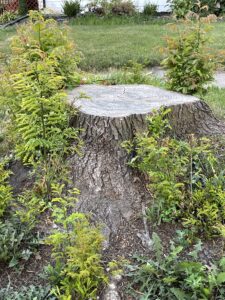
-
The Giving Tree
-
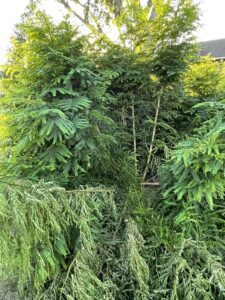
-
A look at the stems of new sprouts
-
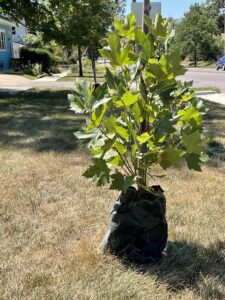
-
the original new tree died, but sprouted from the bottom.
-
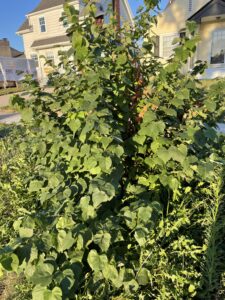
-
Repairs continue as damaged trees sprout.
An Internet search will turn up much information on coppicing. We like the website of the Midwest Permaculture Center.
by Winding Pathways | Sep 9, 2021 | Garden/Yard, Nature, Pests, Trees/Shrubs
We’ve got a peach problem.
Iowa’s frigid winters don’t favor peach trees, but we’ve got a tough one in the front yard that’s withstood temps down to 30 below zero. Each May it graces our yard with pink blossoms that transform into smallish, tasty peaches that ripen around Labor Day.
We love peaches. So do deer. That means that every fall we play a waiting game with them.
Peaches look ripe a few weeks before they truly soften and ripen. When they’re hard as stones they don’t taste good. We know it. So do the deer. This starts the tricky part.
When will they be ready to pick? If we don’t harvest them at just the right time the deer will do it for us. They’ll devour every single one the night before we intend to pick. This year we ran a wide circle of wire mesh around our tree, but we know hungry deer will figure out how to foil it.
-
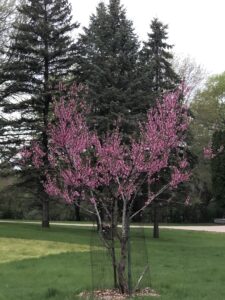
-
Each spring the fragrant pink blossoms grace our yard.
-
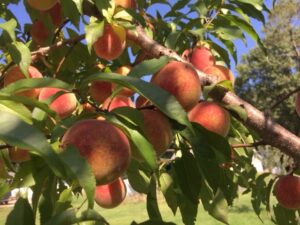
-
Deer sense when peaches are ready to eat.
As we write this on September 2nd our peaches are still hard. The deer are watching and waiting. We know because we found fresh scat just outside the wire fencing last night. We’ll let our readers know who gets the harvest.
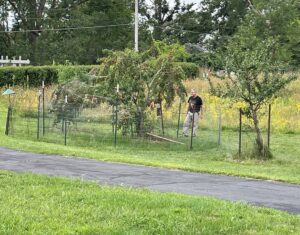
Adding extra fencing and stakes may keep the deer back.
by Marion Patterson | Aug 26, 2021 | (Sub)Urban Homesteading, Flowers/Grasses, Garden/Yard, Labyrinths
In early July we sat on our front porch watching delightfully splashes of color dance in the breeze. A restoration triumph stood stoutly in the wind-blooming compass plant.
Restoring prairies takes patience. We began ten years ago by converting a former mowed lawn into a prairie. For the next few years, our emerging prairie looked rough. A weed patch mostly, but as the years rolled by the “weeds” also called Mother Nature’s stitches, retreated as prairie plants matured and outcompeted them. Coreopsis, coneflowers, monarda, and vervain began adding color to ever more vigorous big and little bluestem, switch, and Indian Grasses.
Then, this year, compass plants that had been flowerless for years, shot spikes six feet into the air. In mid-July, the plant is in full bloom.
Difference Between Domestic and Native Plants
When you plant beans, tomatoes, or squash and many domestic flowers and the fruits of labor are rewarded that same year with fresh vegetables and colorful petals. Not so with native plants. Prairie takes patience. Some native pioneers come on in a year or two but many wait and wait and wait. Sometimes it can take upwards of 15 years for stately compass plants to bloom, so ours may be racehorses to show color in just a decade. More point skyward along with coneflowers, purple prairie coneflower, and rattlesnake master along the roadside in front of our yard.
We have tour prairies at Winding Pathways. Into our oldest Marion has crafted a prairie labyrinth, giving walkers an opportunity to follow a contemplative path surrounded by blooming, dancing flowers and tall grasses.
The “middle-aged” prairie out in the back is a haven for birds, adds color, and is a buffer from the ruined-looking woods where young trees are starting to show amidst the broken derecho tree trunks.
In 2019 and following the August 10th, 2020, Derecho we scattered prairie/open woodland seeds to encourage diverse plants on the east-facing slope.
Our youngest prairie, planted in the spring of 2020, remains in infancy. A mass of black-eyed Susans shines brightly, and many other small bloomless plants show promise to color up as the years go by. We look forward to their future.
We welcome anyone to visit, walk the labyrinth, and enjoy our prairie and the butterflies that skip from flower to flower within it.
-
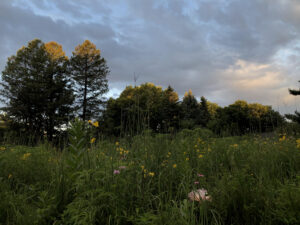
-
Sun rising over the prairie.
-
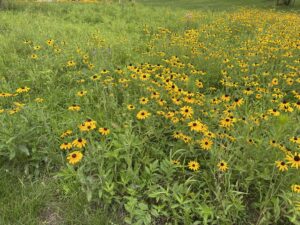
-
Pioneer plants like the Black Eyed Susans encourage people as they plant prairies.
-
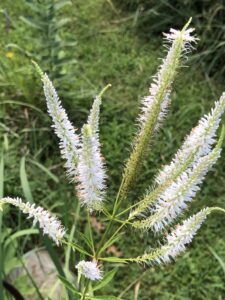
-
The demure, white spikes of Culver’s Root attract pollinators.
-
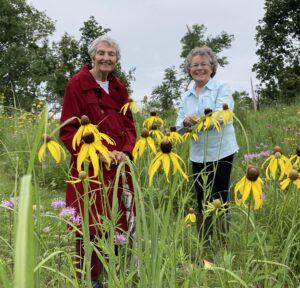
-
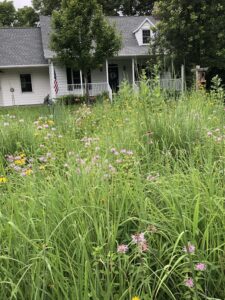
-
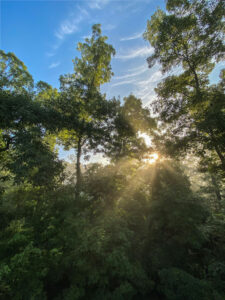
-
Morning sunlight.
by Winding Pathways | Aug 19, 2021 | (Sub)Urban Homesteading, Amphibians/Reptiles, Garden/Yard
Outside our dining room is a tiny pond crafted by our home’s previous owner. It’s smaller than a compact car and is the regular home of water lilies, dragonflies, and a few goldfish we stock to eat mosquito larvae. One morning we were astonished to spot a large frog partly submerged on the pond’s edge. Where did it come from and how did it get here?
We live on an ancient sand dune. Rain quickly percolates downward, so the rubber membrane at the pond’s bottom holds water that would otherwise quickly disappear. No other bodies of water are close by. Could our frog have hopped a half-mile uphill from Indian Creek? Did it come from a nearby neighbor’s pond? And, how would it have got there since we all live on a hill?
We know birds, insects and mammals find and settle in new habitats. They’re mobile and fly or walk until they spot a new home place. Frogs and turtles can walk – or hop -but they’re slow and vulnerable to predators when venturing on land.
Ask the Expert!
We didn’t know how our frog found our pond, so we asked biologist Dr. Neil Bernstein.
He responded by saying that some frogs disperse from wetland to wetland randomly, and there’s speculation that eggs can attach to waterfowl legs. His short answer was, “I don’t know”.
That’s a wise response. Science has revealed many of nature’s mysteries, but more remain unknown. Did our frog somehow sense that a tiny pond way up yonder would be a good place to risk hopping to? We don’t know but we’re certain this wandering amphibian is welcome to enjoy life at Winding Pathways.
-
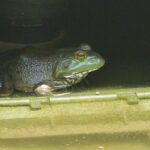
-
Waiting for lunch in the shade.
-
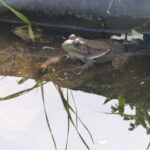
-
How the frog came here is a mystery.
-
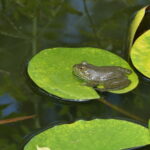
-
Resting in the sun.
-
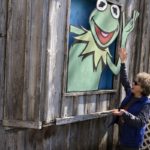
-
Leland, Mississippi is home of Kermit the Frog.
by Winding Pathways | Aug 5, 2021 | (Sub)Urban Homesteading, Garden/Yard, Nature
When we moved to our home in 2010, we immediately began changing the landscaping. The former owner had mowed nearly our entire two acres. It was clipped, manicured, and lacking in diversity. The soil was sand, rock hard, or dense clay. From this sterile, unnatural yard we created a wondrous landscape rich in plant and animal life.
Over the years we removed exotic ornamental trees and replaced the mowed lawn with native prairie. Now, 11 years later, our yard has transformed into more natural landscapes filled with colorful and fascinating wildlife and plants.
In the early years, one thing puzzled us. No earthworms. If we wanted some for bait, we couldn’t find a single one. As the years moved forward, we began seeing a few worms, and then an abundance as they emerged after a light rain. What made the difference?
The Worm Dilemma
Worms are a dilemma for anyone wishing to favor native species. Common worm species are not native. Transported to the New World during early settlement days, they spread like crazy. Gardeners and farmers love worms for their diligent work softening, fertilizing, and aerating the soil. They are great for gardens but cause ecological damage in forests that evolved without them.
Mostly we like worms. They’re an indicator of soil fertility and health and make our gardens more productive. But, why didn’t we have many in the early years of our ownership?
We suspect the former owner did more than mow. He doused the land with artificial fertilizer and pesticides and suppressed plant diversity. Both made life difficult for worms and other creatures.
It took a few years of composting and diversifying plant species but gradually we saw encouraging signs. More and different beneficial insects came to find dinner and a home in our yard. Worms returned with gusto.
We don’t manage our yard to be completely organic. When we spot a poison ivy sprig our small squirt bottle of herbicide takes care of it. Neither of us wants the awful cases of rash the plant caused us in years past. But, that’s about it. We use no insecticides and, except for the poison ivy killer, no herbicide.
Asian Jumping Worms
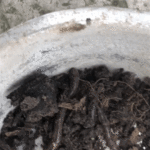
Asian Jumping Worms eat the leaf litter in forests that hold and break down into soil.
A few falls ago we brushed aside the garden mulch and were greeted by a few worms thrashing around at whirlwind speed. They were Asian jumping worms. New to Iowa they’ve been in many Eastern states for years. We easily identified them by their fast movement, white clitellum (the band around them), and their size. They’re just a bit smaller than a nightcrawler. These worms damage forests by eating the leaf layer that nurtures many native species and prevents erosion.
Our chickens dined on the Asian jumpers we tossed into their run, but we’re sure we’ll find more.
by Winding Pathways | Jun 24, 2021 | (Sub)Urban Homesteading, Amphibians/Reptiles, Garden/Yard, Nature
Guest Blog by Leslie Wright
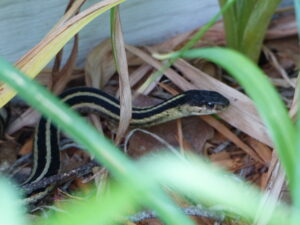
Garter snakes like cool, shady places to wait for a meal.
Just over a year and a half ago, we moved from a home with a suburban postage-stamp-sized yard with little wildlife into a home with a large yard that backs up to a sizable park. Each season we have discovered something new about our new urban “wilderness”. Last spring it was how to identify (and avoid) poison ivy. This spring the theme seems to be reptiles! Earlier this spring I became acquainted with our resident garter snake. Most often it spent time in our vegetable garden but occasionally sunned itself near where I was working in the yard. Though I am not comfortable around snakes I was glad to see him/her – to me a symbol of more abundant life.
How the Adventure Began
Thursday, May 6th seemed like any other lovely spring day. I took myself outside to walk around the gardens and see what was coming up. I walked around to the front of the house to check on hydrangeas I had planted last spring. I had wrapped them in bird netting last year thinking to keep deer from nibbling the tender shoots. To my dismay, I discovered that our resident garter snake had become entangled in the netting, and even worse a much larger snake had also found its way into netting nearby. To my uneducated eyes, this snake looked like a small rattlesnake with a brownish diamond pattern. I was almost relieved that it appeared to be dead. But I knew I needed to rescue my garter snake friend. I was afraid to do this myself – afraid of getting bitten mostly.
So, I started to call and text everyone I could think of to rescue this snake – and me! My husband who was in a meeting, the nature center, DNR. But, alas, I soon figured out I was going to have to tackle this myself if I wanted the snake to survive. So off to Google I went.
Google To The Rescue!
The snakes had netting in their mouths and wrapped around their bodies, multiple times. Google informed me I would need to gently restrain the snake and use nail scissors to cut it free. So, I put on gardening gloves, found a stick with a small fork to hold the snake’s head, and armed myself with nail scissors. Probably more to calm myself, I talked to my little friend while I cut away the netting. Success! After I freed the garter snake I went inside for a moment.
-

-
Netting gets caught in the snake’s scales when it tries to back out of the netting.
-

-
This snake slithered off when freed.
Rounds Two and Three
When I came back out – no lie – he/she had found its way into another piece of netting. So, round two – gloves, stick, and scissors. It was clear I needed to remove every shred of that darn bird netting to make sure it would not harm any other creatures. As I was clearing away the netting, I discovered the second snake was in fact alive. Now I had to save it, too! So round three – gloves, stick, and scissors, and the second snake was free. I later learned this is a fox snake.
All Is Well That Ends Well
I haven’t seen them since but I surely hope they are safe, well, and still visiting our yard.



























